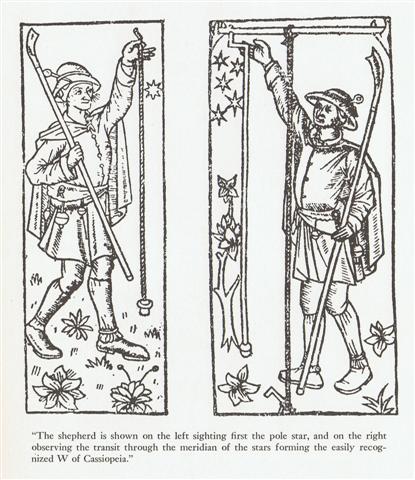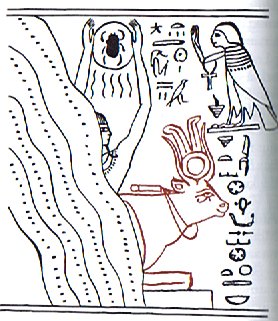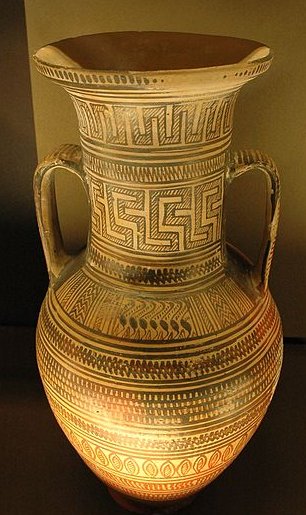Ancient star gazers used a cord with a weight (ideally of lead, the metal of Saturn) hanging down at bottom in order to align one star with another. I have acquired the following relevant pieces of information from Hamlet's Mill.
... In the inscriptions of Dendera, published by Dümichen, the goddess Hathor is called 'lady of every joy'. For once, Dümichen adds: Literally ... 'the lady of every heart circuit'. This is not to say that the Egyptians had discovered the circulation of the blood. But the determinative sign for 'heart' often figures as the plumb bob at the end of a plumb line coming from a well-known astronomical or surveying device, the merkhet. Evidently, 'heart' is something very specific, as it were the 'center of gravity' ... See Aeg.Wb. 2, pp. 55f. for sign of the heart (ib) as expressing generally 'the middle, the center'. And this may lead in quite another direction. The Arabs preserved a name for Canopus - besides calling the star Kalb at-tai-man ('heart of the south') ... Suhail el-wezn, 'Canopus Ponderosus', the heavy-weighing Canopus, a name promptly declared meaningless by the experts, but which could well have belonged to an archaic system in which Canopus was the weight at the end of the plumb line, as befitted its important position as a heavy star at the South Pole of the 'waters below'. Here is a chain of inferences which might or might not be valid, but it is allowable to test it, and no inference at all would come from the 'lady of every joy'. The line seems to state that Hathor (= Hat Hor, 'House of Horus') 'rules' the revolution of a specific celestial body - whether or not Canopus is alluded to - or, if we can trust the translation 'every', the revolution of all celestial bodies. As concerns the identity of the ruling lady, the greater possibility speaks for Sirius, but Venus cannot be excluded; in Mexico, too, Venus is called 'heart of the earth'. The reader is invited to imagine for himself what many thousands of such pseudo-primitive or poetic interpretations must lead to: a disfigured interpretation of Egyptian intellectual life ...
Before the alphabet was invented pictures and numbers carried the meaning. Serpentine streams of water were at the origin of the expansion (<) in spring. Eleven means one more (than 10). In ancient Egypt everything was upside down - up was in the south and down was in the north and the Taurus Bull was a Cow. The Sun was like an insect (6) instead of an octopus, a spider, or Sleipner (8).
The Egyptian glyph for heart (F34 in Gardiner's list) looks like an urn or like an amphora with its handles twisted around from vertical (male) to horizontal (female):
Given such ideas it seems reasonable to guess the pair of hanging objects at left in Ga1-2 were meant to illustrate a plumb line and a pair of stars:
But Ga1-2 could hardly correspond to the position of a heliacal star. Instead the opposite side of the sky should be studied in the night in order to find out where the Full Moon should be. The plumb line of an astronomer was not used in the daytime. May 26 (146) + 182 = 328 (November 24). Or considering the fact that the 'plumb line' is at left - i.e. earlier in time - we could count 145 + 182 = 327 (November 23). A sharp eye (ain) was necessary to find the searched for alignment between the stars. However, in my presentation of this glyph line with all its details I have chosen to count 183 days from the heliacal date of a star to its nakshatra position close to the Full Moon:
From MARCH 21 (80) to SEPTEMBER 20 (263) there were 183 days and here I have denoted this distance with *183.. To distinguish between heliacal stars close to the Sun from nakshatra stars close to the Full Moon the former have here been marked blue and the latter black. ... When the new moon appeared women assembled and bewailed those who had died since the last one, uttering the following lament: 'Alas! O moon! Thou has returned to life, but our departed beloved ones have not. Thou has bathed in the waiora a Tane, and had thy life renewed, but there is no fount to restore life to our departed ones. Alas ... (Makemson, The Morning Star Rises.)
|
|||||||||||||||||||||||||||||||||||||||||||||||||||||||||||||







